Star Date: March 2010
Northern & Western Uganda – Kadepo Valley to Ft. Portal
Hello Dear Family & Friends!
Bo ni. Seave?
(Hello! How are you? Batwa Pygmy)
Hey Muzungu. How are you? Are you steady?
(Hello white person! How are you? Street boys in Kitgum)


Lions between us and the toilets!
(in remote Kadepo Valley, near the Sudanese border).
“What the caterpillar calls the end of the world, the rest of the world calls a butterfly!”
(Lao- tzu, Chinese Daoist philosopher 570 B.C. )
Lions between us and the toilets! A helpful young man from the back of the truck convinced us to try 100us worth of the local date like “sweets” from the village, “But don’t eat too many”. Riding along we snacked on the peculiar fruits eating half a dozen each. That night we discovered that even 6 were too many as each of us made several 100 yard dashes to the toilet in our camp. Flashlights blazing, it wouldn’t have been wise for anything to get in our way – including the monkeys, water bucks, buffalos, gazelles, or the twenty or so jackals prowling around. Toilets full and bowels empty we settled in about 2 am to get some sleep. Awakened to ROARS !!! we were told that two lions had passed through the camp between our ‘banda’ hut and the toilets! A close call. An hour earlier and we would have literally had the sh** scared out of us for sure!
Trying to get to the lost valley of Kadepo National Park from Kaabong we were told that the mini bus hadn’t come that day. Sitting for 3 hours near a truck that might head that direction, Joseph finally made a deal with another truck driver that looked promising. The detours through remote Dodoth and Karamojang villages along the way, to drop off sacks of grain, was the highlight of the journey. To see two ‘wazungus’ on the weekly truck took everyone by surprise and the Karamojan would crowd around to look at us as we looked at them, everyone smiling and shaking hands all the while. Hoots of excitement ran through the crowd as Joseph would show them their pictures on his screen; a first look at their photo for most of them.
Jumping off the truck at “Tsetse Central”, Kadepo’s Nataba Gate, we sat in the stillness, waiting for the Park’s truck to take us to the camp. Noting the date as we paid our entrance fee we realized that we had been traveling in Africa for one year already. This large, daunting continent is beginning to feel like home as she welcomes us to explore her hidden secrets.
A lively array of animals lined our path as we drove the 12 kms to Apoka Camp. The only guests in the whole valley, we were overtaken by the thrilling sense of ultimate isolation, a rare taste of Wild Africa in the raw. Kadepo Valley, 700 km north of Kampala, on the borders of Sudan and Kenya, is home to a host of dry land species found nowhere else in Uganda. Perennial waters attract large herds of elephants and buffalo during the dry season. Dominated by 2750m Mount Morungole, this open tree savannah oasis is surrounded by semi-arid desert. Home to 88 mammal species such as cheetahs, leopards, tree climbing lions, bat-eared foxes, hyena like aardwolves and 500 bird species, it harbors 5 primates, including the endemic bush babies. Although many species hide in the remote outer reaches of the Kadepo Valley, Narus Valley in which our camp was located, had year round watering holes attracting a steady stream of thirsty visitors. Worn thin by the arduous travel just to reach our goal, we decided to let the animals come to us. We walked to the neighboring luxury Apoka Lodge, (who hadn’t seen a $300 pp guest in weeks) and hung out reading in their exquisitely done pool and recreation area which blended easily into the dreamlike African savannah below. Herds of placid animals paid their respects at the two watering holes.
Later in the day, like running up against the side of a large Greyhound Bus, we bumped into ‘Bulbul’, the enormous bull elephant who lives in our camp. One evening he happened on to the remains of a barrel of ‘balu komboti’ the local hooch, left by a bunch of partying park employees. He got drunk and staggered around, to the amusement of the workers. Hooked, he decided to stay put. Now he definitely gets invited to any parties. This friendly 12 ft party crasher spends his days eating and drinking at the 3 watering holes, as local workers and guests give him the wide berth he deserves.
After 3 relaxing days we were faced with the challenge of how to continue our journey south. Literally stuck, due to a broken National Parks truck and lack of visitors, we resorted to shaming a Lutheran Aid relief worker and his family (who had curtly said, “No”) into giving us a ride to Karenga 20km away; as getting dropped off at the isolated road junction would have been too risky. The main job of rangers up here is to try to protect the animals from armed Sudanese, Kenyan Turkana or Karamojan poachers. Asked what happens to the offenders we were told, “Most of them get shot in the gun battles.” Survival of the fittest up here.
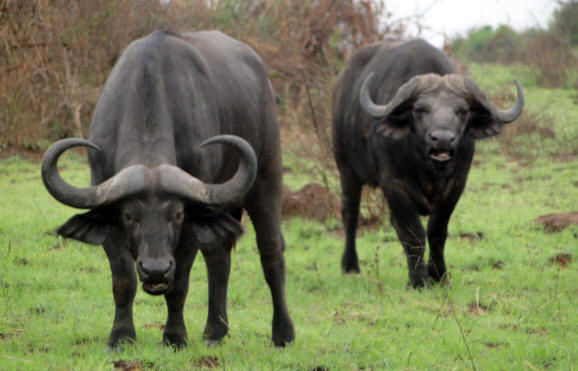
Buffaloes with an attitude. Check out the “Supremes” hair styles.
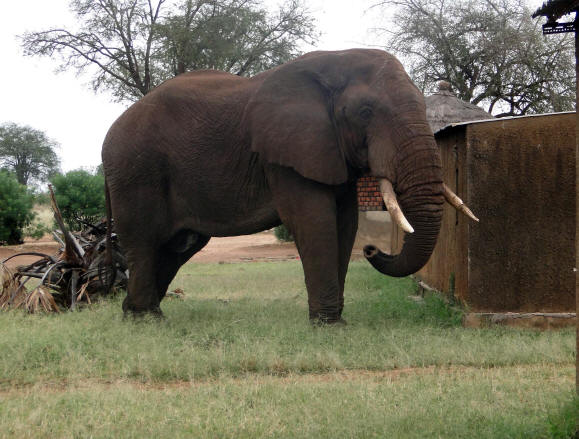
Running into Bulbul in our camp was like running into the side of a Greyhound Bus.
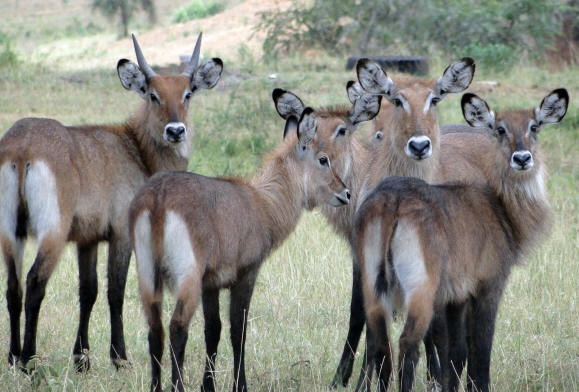
All of the grazing animals have striking markings, even the ears of the plain waterbucks have interesting patterns.
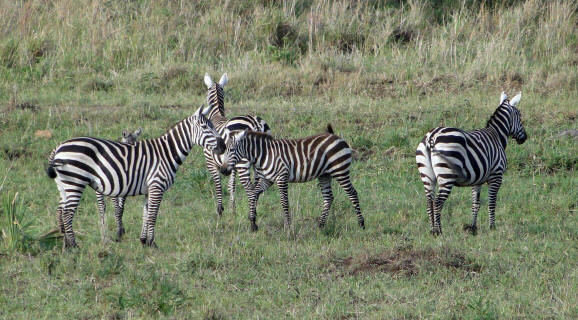
Zebras, right next to our huts. The lions favorite food.
Uganda never saw the great influx of European colonizers that neighboring Kenya and Tanzania did. When the UPC was formed, it quickly led Uganda to independence from the British in 1962. The British had favored the powerful Buganda people for positions in the government. The Acholi and Lango mainly composed the military and as resentment grew after independence, intertribal conflicts began to surface. The ‘kabaka’ king, Edward Mutesa II, became president but when his rule looked like more of the same the young army chief of staff, Idi Amin stormed his palace and sent him packing. (Tribal ‘kabaka’ kings were outlawed but recently reinstated to rule their tribes as monarchs only). Journalists were expelled as rumors leaked out about mass graves, results of the military killing thousands of opponents. Whetting his appetite for power Amin started a reign of terror with atrocities making international news. Utilizing the newly formed “State Research Bureau” a secret police force, Idi Amin started eliminating rivals over the next 2 decades; first opponents, then as with Pol Pot in Cambodia, learned teachers, doctors, lawyers and finally trying to wipe out several opposing tribes with genocidal massacres on villages.
All businesses were nationalized and Asians or Indians were given 30 days to leave empty handed or be killed. As portrayed in the award winning movie, “The Last King of Scotland” Idi Amin turned into a power hungry dictator who would go down as one of the most deranged and ruthless in history. Following his war with Tanzania and subsequent overthrow, the country was plagued by civil wars and terror from remaining troops looting towns then ivory or big animal meat from game parks with machine guns, killing whatever was in their path. Obote declared himself president for the second time in 1981 and was thrown out by Okello. A guerilla army of 27 sprouted up in the northwest under the leadership of marxist leaning Yoweri Museveni. The numbers of the NRA grew to over 20,000, most of the soldiers young orphaned boys. Still suffering from the terror of the mobs of military soldiers of previous years the new movement of the NRA was tightly disciplined, with offenders executed. They swore that the army would never again disgrace Uganda. When the NRA ran over Kampala in 1986 they promised to flush the government of the collaborators of Amin and Okello and to stamp out corruption. 40,000 rebels in the northwest were offered amnesty but a few remaining rebels formed the Lord’s Resistance Army. Joseph Kony their leader, grew paranoid and increasingly delusional, turning his aggression away from government troops and focusing on civilians, “even his own tribe”, we were told. They killed people who wouldn’t follow his government based on the Biblical Ten Commandments. Sounding like a resurgence of the European Catholic Church’s Inquisition in the late Middle Ages, he mutilated and killed villagers in the northwest, raping and abducting women and children for soldiers and sex slaves. “Onward Christian Soldiers!” Eventually hundreds of thousands fled their home to IDP camps (Internally Displaced Persons) and the Lord’s Resistance Army moved their bases across the border to the D. R. Congo. Kony continued his attacks until 2009 when a tentative peace agreement was reached. It is thought that he was just using this time to rebuild his army. He has begun carrying out his acts of terror in neighboring D R Congo and Sudan. People still remain too terrified to return home to their remote NW Uganda villages. Towns such as Gulu are surrounded by impromptu camps huddled together for safety. No one trusts the word of this fanatic. His reign of terror must be stopped. History has shown that most evil implodes from the inside, but how long will this take at the expense of these innocent children? We pray this ends soon as the international community becomes more aware.
We each should support a cause that ignites our soul, to help give back instead of just taking; helping this planet and the amazing people who share it. If someone goes through life just as a spectator they should be charged admission.
Check out: www.kony2012.com to lend your help if this speaks to you. Together we CAN stop this. 80 million watched this video in the first week it was posted. Watch it. Share it.
The 1990’s were times of economic prosperity and growth for Uganda. One of the keys was the bold move of inviting the efficient, entrepreneurial Asians and Indians back to resume their businesses. Better the devil than the deep blue sea, leader, Musveni, changed the constitution and passed an amendment that allows his unlimited reelection. He won his third election by 59% in 2006, amidst discrepancies, (such as in Florida with Bush!). He will run again in 2011 although no real opposition has surfaced.

Our ‘limousine’ to the park. A rough ride but a fun adventure.

One of the many villages along the way.

Villagers were shocked to see 2 ‘muzungus’ on the weekly supply truck.This smart fellow was sporting a feather in the back of his new hat, announcing to the village he was looking for a new wife.
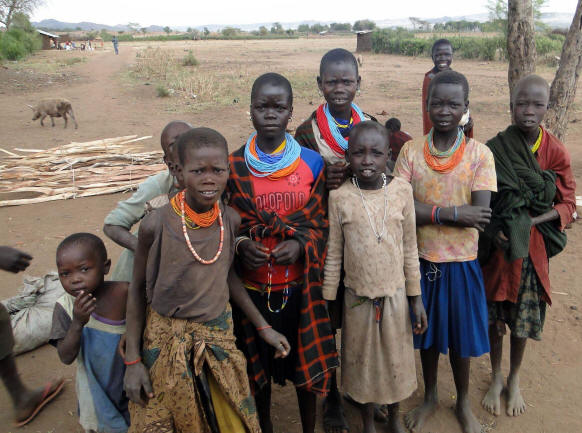
Notice the diagonal scars carved into the girls foreheads for beauty. Each village seems to have a little different pattern.
Uganda has had a rocky political history over the last few decades, ranking only 154 out of 177 on the UN’s Human Development Index. Once the rampant corruption in the government is curtailed this country is a land full of promise. The leery citizens have suffered greatly and are only now slowly recovering. As always keep informed on any changes in the political situation before venturing to remote corners or city centers of ANY country worldwide.
Just as the poor youth of America turn to the military in an attempt to escape the helplessness of their situation, we were surprised to learn that thousands of young ‘mercenary’ soldiers from Africa are employed to fight in the armies of the United States. We met several such young men who had spent 5-10 years training first in the US then fighting in Iraq or Afghanistan. Paid less and lacking benefits these young guys get chewed up and spit out, many suffering from the side effects of war. Will the negative devastation of war ever become a thing of the past?
Adding injury to misery, erosion from over logging, caused the side of Mt Elgon to give way near Bududa, burying hundreds in mud and causing 300,00 to lose their homes. Instead of replacing forests with strong rock and dirt terraces for crops like in Asia, temporary gardens are scattered along the steep slopes, just waiting to be washed out in the next torrential rain storm. With drought, natural disasters, hunger, poverty, unemployment, Aids, malaria, an average age span in the 40’s a way of life in Central Africa, it is common to hear people mourning the loss of a loved one. Most stories are about how many family members have died of Aids. Wooden coffins decorated in bright purple or black, some with intricate golden hobnail designs, line the side of the road; often transported on the back of push bicycles. We were told that when the Aids epidemic was at it’s height, rows and rows of coffins marked the beginning of each town. A sign of the times. One of the first countries to be hit with the Aids epidemic the rate, thanks to education, had dropped from 25% in the 80’s to 4% in 2003 in Uganda.
Unfortunately President Museveni and his outspoken wife, spurred on by their Evangelical Christian beliefs has reversed Uganda’s policy on condoms, pushing abstinence instead and the result is, not surprisingly, a rise in the infection rate to 6.7%. With the median age 15 and a total destruction of the environment, this same administration is pushing it’s citizens to have more babies, resulting in an annual growth rate of 3.6%, one of the world’s highest. Several educated young men offered a possible reason: “The government needs a class of poor slaves to build the country, also if the people live in poverty they are more easily controlled.” We were amazed at their insight.
President Museveni has promised free primary education for all but still many large families can’t afford to even buy the notebooks or uniforms needed ($1.50 a semester) and 1/3 of the country remains illiterate.
Yesterday while riding in the back of a ‘saloon car’ (shared taxi) the young man squished in beside me shared that he was going to visit his 14 year old brother in the hospital, sick with malaria. When arriving at our destination he received a call informing him that his dear brother had just died. Death is a way of life here. My tooth broke in Ft Portal and I made an appointment with the Head of Dentistry at the regional hospital. After a delay of over an hour in his less than clean office, all the while sweating and gazing cautiously at posters of mouth lesions in Aid’s patients, I bolted upon learning from this head dentist that the sterilization machine for the hospital was broken. What of the 60 plus patients lined up moaning with aching teeth in the lobby? Possibly like the volunteer surgeon told us in his remote outpost hospital, “When the sterilization equipment fails, we must do the best we can; leaving the patients in the hands of Nature. Upon returning to our guesthouse in Entebbe to make a quick visit to a reliable dentist, we learned that Irene had suffered from malaria while we were up north and the 2 year old baby of Diane had just died overnight from typhoid. Few doctors are available and prescription drugs are too expensive. The well known homeopath we got to know in Dar es Salaam claimed a 100 % cure rate for typhoid with cheap homeopathic remedies, after 20 years of practice. Plus there is low priced MMS 1 available (see our Thoughts on Health page) if only the health education was available. Even with education old superstitions die hard. We were talking with 2 well educated young men when a mentally disturbed woman went running down the street. They said convincingly, “Oh, she is the third wife of a man in town. The other 2 wives cast a spell on her and now she is crazy. Beliefs such as these are slow to change. But they will. Such hardships in life here. The smiles radiate even brighter once we understand the realities facing Ugandans.
Even with the above facts Uganda remains a safe country for visitors and promises to overwhelm you with smiles. Very polite and genuinely friendly, these complete strangers will often greet you as you pass and even ask how you are doing? Expecting you to do the same, often when you say, “Hello” you will be met with the response, “Fine”. Show some empathy towards these wonderful souls and you will be rewarded ten fold.
Booted out of the SUV at Karenga, we stared at our surroundings as we were told that the bus doesn’t come until tomorrow through this dusty widening in the road. Due to recent drought conditions it was one of the first villages we had visited in 7 years that didn’t have vegetables for sale – only onions and sweet potatoes. It was a start. Determined to let events unfold, I found Sabella and proceeded to patch together our cooked meal of the day. With much ingenuity and scrounging we were sitting down to a tasty meal of boiled yams, beans, plus fried cabbage and onions. We paid Sabella for her charcoal and left behind all the remaining food we had unearthed. She and her 4 children were alone after her husband had been killed by raiders. We were deeply moved as she offered that we could spend the night on the cement floor of her tiny restaurant if we were stuck in Karenga overnight. She who has nothing was generous beyond words, while the well set “Christians” who dropped us off had forgotten the meaning of helping your neighbor. Again are westerners here to teach or learn? Eighty five percent of Uganda is Christian, with an emerging new culture of ‘wanna-be western’ church goers. It is the land of the ‘Glory to God Guesthouse’, the ‘Lord’s Shepherd Butchery’, the ‘Praise Be God Cheap Shop’, the ‘Hope Driving School’ and our favorite ‘Miracle Anti Corruption Coalition’!
We spent several days in Kitgum and Gulu, both towns looking like miniscule dots on the map of northern Uganda upon arrival but now seeming to be BIG towns compared to the places we had visited over the last month. We were able to get to know many young victims of the violence hanging around the market, now living in safety on the outskirts of town. Still suffering from the pains of recent terror by the Lord’s Resistance Army, it was heart warming to talk to optimistic townspeople looking forward to a better future. A large bowl of vegetable curry and naan, prepared by a recent returnee from Hyderabad, India was just what we needed to put a wide smile on our face, in these sometimes disturbing surroundings.
Taking the bumpy dirt roads south through Hoima we arrived in the pouring rain and ran into our room in Masindi. When the clouds parted we were walking down the road and someone yelled from across the street, “Are you from South Africa? Would you like to share a jeep to Murchison Falls” We responded, “No, Hawaii. Yes, we would.” Scottish born Ian and Laura were public bus travelers on fast forward, chalking up countries they have visited, 180 to date. We enjoyed their company and recent tales of western and southern Africa. Benlo from Montreal, Canada rounded out the circus as we feasted our eyes on stately Rothschild’s giraffes, a crafty leopard, families of elephants and a cousin of the kob, definitely a prototype for a ‘Star Wars’ character. The afternoon was spent boating up the Nile River surrounded by endless blobs of floating brown and pink hippos, crocodiles dozing wide mouthed in the sun, flocks of exquisite water birds and herds of elephants having a drink next to thousands of buffaloes and antelope. Following chunks of foam upriver we heard the roar as the mighty Nile exploded through a narrow gap in the Rift Valley escarpment, plunging 43m below into a churning pool. Uganda’s largest reserve has had many famous visitors over the years such as kings and queens of Europe, Winston Churchill in 1907, Theodore Roosevelt in 1909, and Humphrey Bogart and Katherine Hepburn while filming the “African Queen” in 1951. The least appreciative visitor was Ernest Hemingway in 1954 whose plane clipped an old telegraph wire while flying over the Falls and cart wheeled into the forest below. He and his wife were taken to Butiaba where their rescue plane crashed on takeoff. Some trips are better than others!
From Ft. Portal we spent a day driving around with Jonathan checking out some of the scenic crater lakes in the area. Lake Nkuruba reminded us of Puna’s Green Lake on the Big Island of Hawaii. By minibus ‘taxi’ we headed west towards Lake Albert. No vehicles in site at the junction we finally climbed aboard the open back of a large cargo truck for a surreal trip in the wide open air through Toro-Semiliki Reserve (no charge) past antelopes, elephants, warthogs, baboons, and buffaloes. Covered in dust, the road just stopped abruptly at the lake and Joseph found the Garden of Eden on the water. What’s in a name? Far from paradise, this secure compound was the lone hotel on the lake but oddly had only a cement wall facing the beautiful water view. Without running water or electricity this small dusty fishing village was far from Eden, but an interesting place to walk the shore and observe the fishermen and throngs of water birds.
In search of Pygmies we jumped on a local minibus ‘taxi’ and headed toward the Congo. Just past Semuliki Hot Springs, where the Semiliki River forms the Congolese border, extending over Congo’s vast steamy Ituri Rainforest, we were shoved out the door in the middle of nowhere. Seems to be one of our favorite scenarios while traveling. Following a dirt road through the forest we happened on the village of Ntandi; home of the Bakonjo & Amba people. One km further (you must ask the way) is the shabby little village of the Batwa Pygmies. Hunter gatherers of the rainforest, these tiny folk were only forced out of their ancestral forest homes into a village 4 years ago, when their home was turned into a National Reserve. The Batwa are an extension of their natural surroundings, totally self sustaining and non aggressive. They have much to teach about living in Nature, spirituality, family values and survival. As man distances himself from our origin in Nature, love of money and aggression for gain surface. Possibly this is why these marginalized tribes are looked down on and called lazy. Take Batwa King Nzito, put him in a business suit with a brief case, a cell phone constantly ringing and working 50 hours a week shuffling papers and we would call him modern or successful. How can we judge what we can’t understand?
Like all their brothers of the forest, animals, birds and flora with whom they are one; life has changed forever. These strong small ancient inhabitants are to be admired. Not wanting to impose we sat with the villagers, showing photos, blowing up balloons for the kids, looking over their pipes and musical instruments made from the forest. One stringed instrument was being crafted out of a turtle shell, sinew strings and carved wood by the man sitting next to us. Tiny 67 yr old, Asta Jona, a real character, never left my side, fascinated by her new ‘muzungu’ colleague, rubbing my white skin and soft hair. All the women were thrilled as I handed out little bars of fancy hotel soap to take a coat of dust off. I’m sure the kids screaming through their baths the following day were wishing it had been sweets or ‘bonbons’ instead.
They explained that the 10,000us each fee went towards food for the village and we gladly donated as they proudly did a couple of dances for us, spurred on by our moving and clapping. I sat talking with the women as Joseph spoke to tiny King Nzito and his brothers about possibilities for change, now that life in the forest is gone forever. They are very strong willed and determinedly chase missionaries away, knowing Nature as their God.
As the Batwa Pygmies mix with surrounding tribes, the height of the off spring is increasing. Only the elder members or royalty are still (PC) ‘vertically challenged’. The same height standing as we were sitting one Pygmy asked, “Why are you so tall?” We replied that, “God made people in all sizes to make life interesting.” Joseph also gave them ideas on how to attract more visitors, set up a cultural center for education and to create awareness of their plight; making the tourists feel welcome and at ease being a main goal. As with the Mountain Gorillas the Batwa Pygmies are nearing extinction. Over a puff of ganja in their unique gourd pipes, they also discussed ideas such as growing crops to feed the whole village in the small center area. Allowed to still hunt with their tiny bows and gather in the forest they need to supplement the villagers food supply. Adamantly they stated, “We have never grown crops!” We all end up doing things in life that are new. We retold the wise words of Lao Tse to these brothers of the forest and Nature: “What the caterpillar calls the end of the world, the rest of the world calls a butterfly!” Ahhhh! They understood.
And so it goes…………………………………..Next month tracking endangered mountain gorillas. Until then lets remember that when change brings an end to things as we know them, it is really only the beginning of something new and exciting. Thanks again for sharing this website with your friends. We count on you to help get the word out what a great world we live in! Keep Smiling! Glad you stopped by. Thanks for keeping in touch! Take care!
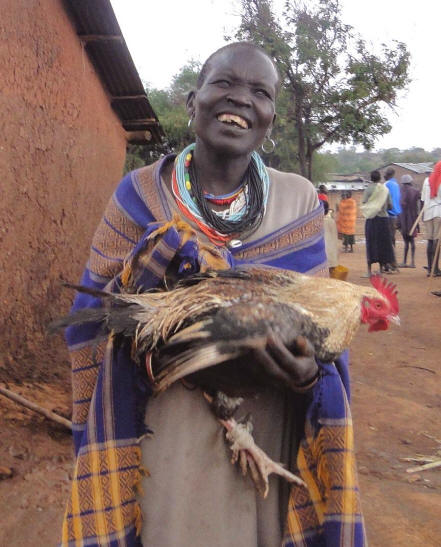
Guess what’s for supper?

One of the many NGO vehicles buzzing around.
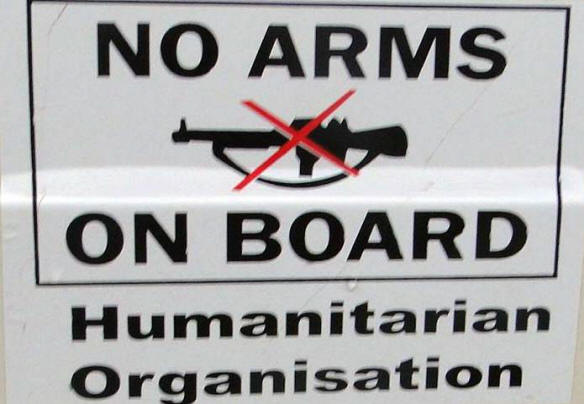
All the relief workers vehicles (usually white color) have stickers stating there are no guns on board.
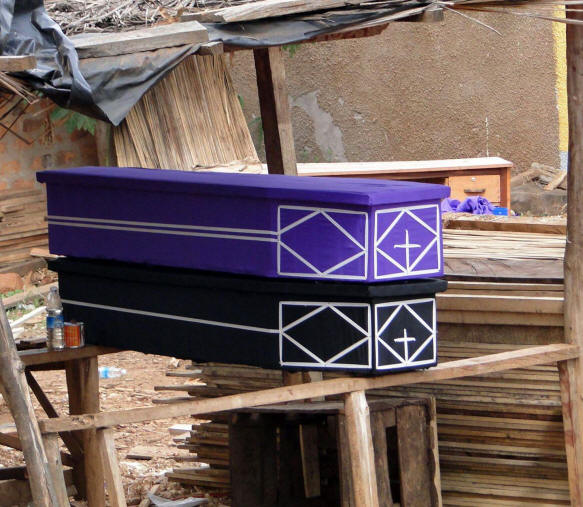
Coffins, some with golden hobnail designs, are displayed in every town.

The transition from village to town comes with all the modern conveniences – delivered to your door.

Isn’t Life Great?? This African Raggedy Ann was running off to school beaming one of those famous bright Ugandan smiles.
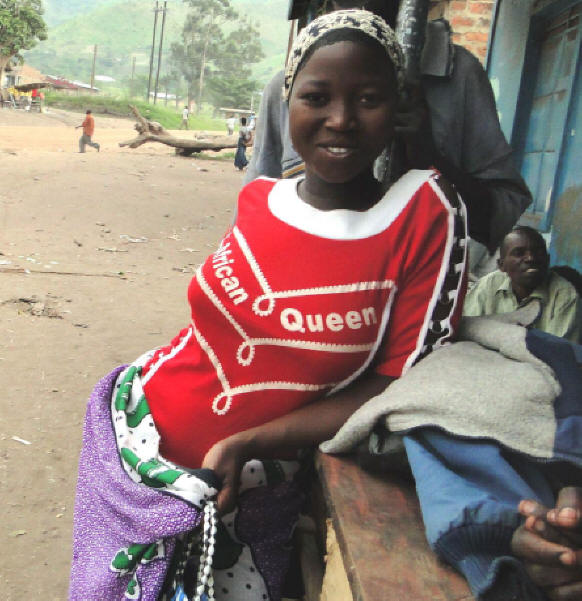
The real African Queen.
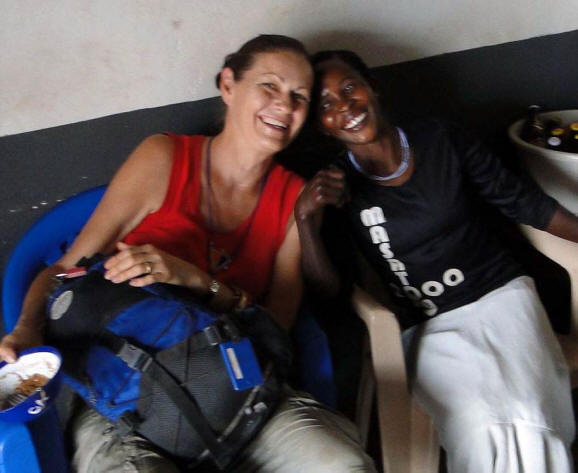
Sabella had a heart of gold. We were deeply moved as she offered that we could spend the night on the cement floor of her tiny restaurant if we were stuck in Karenga overnight.

Murchison Falls. We heard the roar as the mighty Nile exploded through a narrow gap in the Rift Valley escarpment, plunging 43m below into a churning pool.

Hippos are great natural lawn mowers, consuming up to 80 lbs of grass each night.

A royal ibus posing for us along the Mighty Nile.
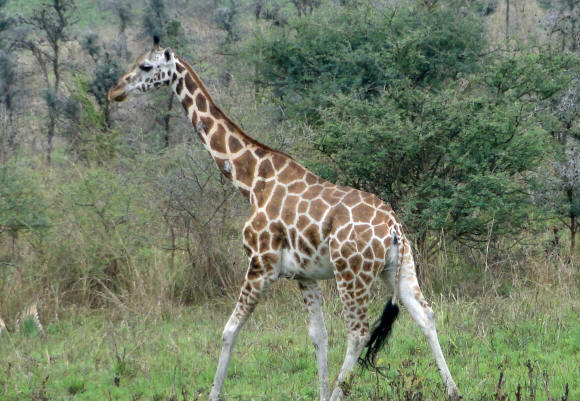
Stately giraffe, one of 6, near our jeep.
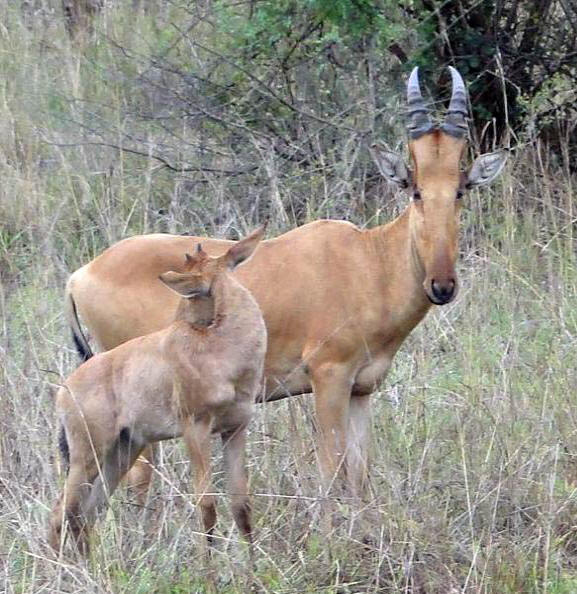
Cousin of the kob, these strange looking hartebeest are definitely a prototype for a ‘Star Wars’ character.

A well camouflaged leopard in the thicket. We noticed him when he flicked the white end of his tail.
Love, Light & Laughter,
xoxoox Nancy & Joseph
Travel notes:
$1.00USD = 2,000 Uganda Schillings (us)
Kadepo National Park:
Ask around Kaabong and hitch a ride on a truck to ‘Tsetse Control’ 2km from Nataba Gate of Kadepo Park (10,000 each). You can either hike in or just get the truck driver to drop you at the gate for an extra 5,000 total. Arrive early afternoon if possible and try to stay 2 nights. The journey is fantastic but rugged and tiring so plan to chill for a couple of days. At the gate you can bargain to pay 3,000 a km to the Parks ‘banda’ camp. You can go on a game drive or just let the animals come to you.
Let Phillip help make your stay comfortable at the bandas. We had a large banda hut without bathroom for 27,000us a night. Clean toilets and basic showers (ask them to spray for mosquitoes if they are swarming in the bathrooms). If we had had our own toilet (for 50,000us) we would have missed the lions between us and the bathrooms! Also the water wasn’t even working well in the self contained units so check first. David can cook a meal for you (about 7000us) but you must order ahead. You can sit out on the back porch and watch animals come in for a drink at sunset.
Walk over to the adjoining Adko Safari Lodge to see how the other half lives. At $300 per person per day it is a bit different than the neighboring park accommodations. Their pool and dining room has fantastic views of the savannah and animals at the watering holes. We hung out all afternoon after asking the manager for a tour and just keeping a low profile. They have few guests at that price.
Getting out was a problem. The park truck kept breaking down and was expensive to Karenga (3,000/km) so we “shamed” a Lutheran Aid Relief worker and family into dropping us in Karenga. We certainly fell in the category of needing some help! As we shared the single front seat (me curled up on Joseph’s lap) for the 20 km it wasn’t a hassle for them at all and we still don’t understand why they refused to help us when asked nicely and offering to pay fuel – especially since they had a large roof rack and they were going that way anyways. Maybe workers just get jaded after a while.
Karenga:
One little dive for 10,000us was available and Sabella offered the floor of her restaurant for the night, if we hadn’t been lucky enough to catch a truck south. Basically only a widening in a dirt road, Karenga has no amenities, including no vegetables in the market! A first for us – due to the drought.
Kitgum:
Acholi Pride Guesthouse, phone # 0772 687793. One block from the taxi stand. Across from Los Angeles Hotel, good, small clean room in the back. Room # 10 the only one with an outside window. 25,000 us double with bath. Everything was broken when we arrived: the toilet fell over, the front door wouldn’t lock, the mosquito net frame fell down but we got the manager to fix it all and now it’s a great little room for the price.
Gulu:
Acholi Ber Country Hotel: Looking like a Chinese hotel with 4 stories of yellow cement and blue windows, this new place is a great deal – modern and clean. End rooms (such as 222 are a little smaller and less expensive, 25,000us) but you can bargain down the 30,000-35,000 rooms.
Masindi:
Karibuni Guesthouse/Snacks: Market St. Plot 3A, hidden behind store fronts this quiet little hotel is clean and well maintained. (Phone # 0772-923477 or 0783256605) Let Sam (the conscientious owner) Joseph and Beatrice help make your stay in Masindi more enjoyable. Stay down the main corridor, last door on the right # 1? , large room w/bath (20,000us longer stay,-25,000 ).
Murchison Falls Nat Park:
Not a place to access via independent means. We left at 6 am(6:30am would have been plenty time) in the dark from Masindi – got to the gate at opening at 7am. A rough dirt road, we only saw a couple of private vehicles all day. The rest were a few tour groups, filled to the brim -so probably no hitchhiking through this remote area.
We went together with 3 other muzungus, Ian, Laura and Benlo, and rented a jeep from Hotel Aribas (#701-160938). For all day (6am-7pm) 250,000us bargained down from 300,000us (although Benlo was quoted a price of 200,000us for himself, so ask around). The driver was great and jeep was good but lacking the pop up top – only a hole to stand up in for viewing.
Ft. Portal:
Royal Guesthouse: Kamuhigi Rd., at the top of the hill, left side (phone # 0715-168135 or 0775308259). (Left off highway then first left, 1/2 block on left side). One block away from the road and you feel like you are in the middle of a green countryside. Helpful, friendly, Wilson, Ronald and Jonathan help with any questions. The place is quiet, extremely clean, and friendly. A local off the beaten path place for only 16,000us. Room # 3 the best with 2 windows. Spotless bathroom right across the hall.
We heard terrible things about the Rwenzori Travelers Inn, the big one along the main road just down from our place (ie 2 hour wait for food, bedbugs and no working internet – must have been a change in management).
Avoid the Regional Hospital! As with anywhere insist on sterilized or new disposable instruments. Double check for sure – or have someone check for you.
Enjoy an authentic pizza, made by an Italian, in his new Italian Restaurant near the clock roundabout up the hill. Just ask. Closed Mondays. You can get wood fired small (1/2 size) or large pizzas for a reasonable price.
Ntoroko:
Garden of Eden: Lake side of the road a little past the drop off point. Far from Paradise! but as good as it gets here (10,000us). The others are all the same price but noisier from bars. This is a secure enclosed compound, with very basic rooms and shared toilets. Moses and Hope try to make their hotel bearable.
Take the taxi minibus to Ntandi, 6000us, and get dropped of at the junction under the big tree. Walk about 2km to the village. Ask for someone to show you to the batwa pygmy village – you have to pay to visit so make it easy on yourself and have one of the villagers escort you.
After your visit walk back to the junction, and catch a passing minibus to the Karugutu junction (2000us). Drop off and try your luck for a ride – probably in the back of a truck to Ntoroko on Lake Albert (4,000us) for free through the Reserve. Retrace your steps back to the junction – probably by hitching with a truck and then wait for a minibus back to Ft. Portal (6,000us).
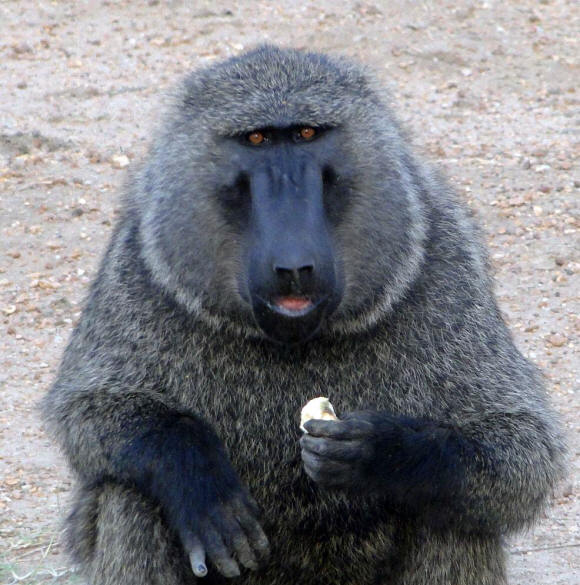
An enormous male baboon having a bite by the side of the road.
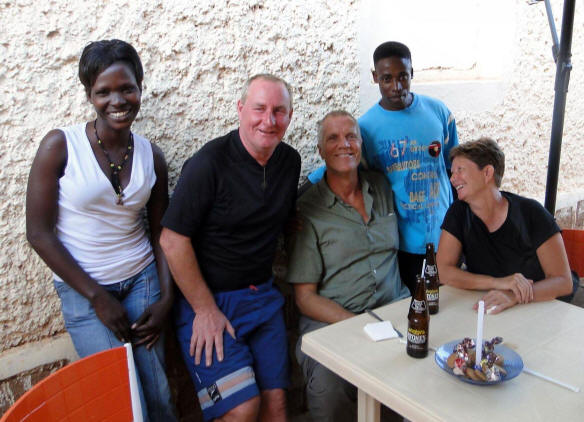
Make a wish! Celebrating Joseph’s 61st birthday with Scottish Ian and Laura, our fellow dromomaniacs (an unquenchable desire to circumnavigate the globe).
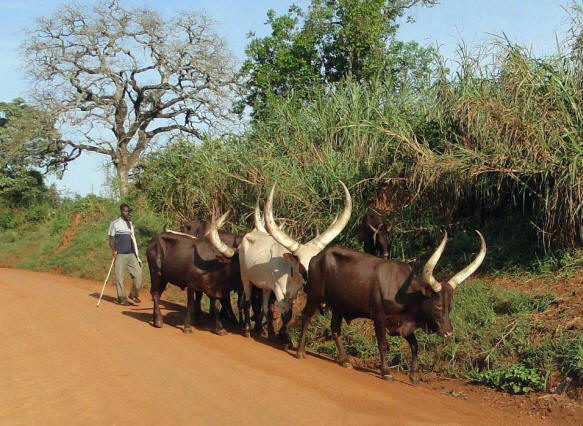
Now those are longhorns. Good thing they aren’t up in Karamojang territory! They would excite the blood of any cattle raider.

The only way from Karugutu to Ntoroko, on Lake Albert. Although dusty, we had a surreal open air ride through Toro-Semiliki Reserve with herds of gazelles, elephants and buffaloes surrounding us.
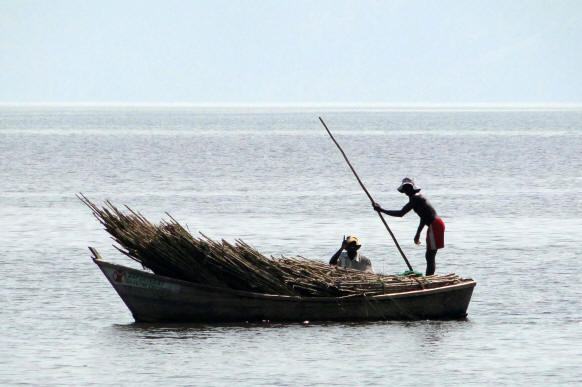
Fishermen returning with a load of papyrus for making thatching on the villages huts.
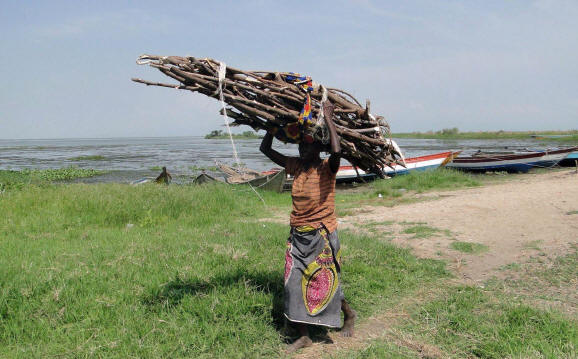
Firewood to cook fish, matoke and rice.
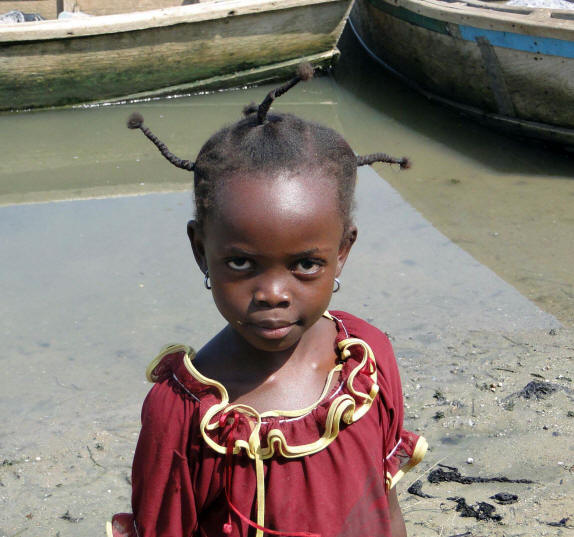
AM/FM antennas.

Lake Nkuruba, one of the over 30 crater lakes near Ft. Portal, reminded us of Puna’s Green Lake on the Big Island of Hawaii.
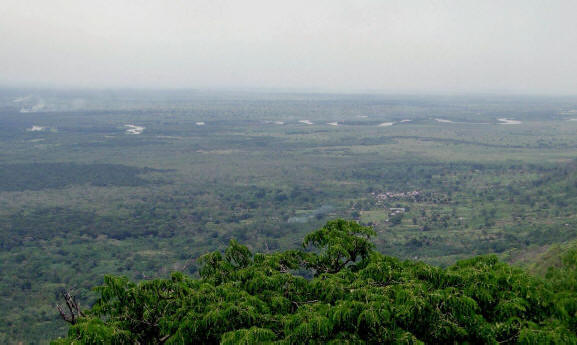
A stunning vista across the Semiliki River where it forms the Congolese border; extending over Congo’s vast steamy Ituri Rainforest, home to many pygmy tribes.
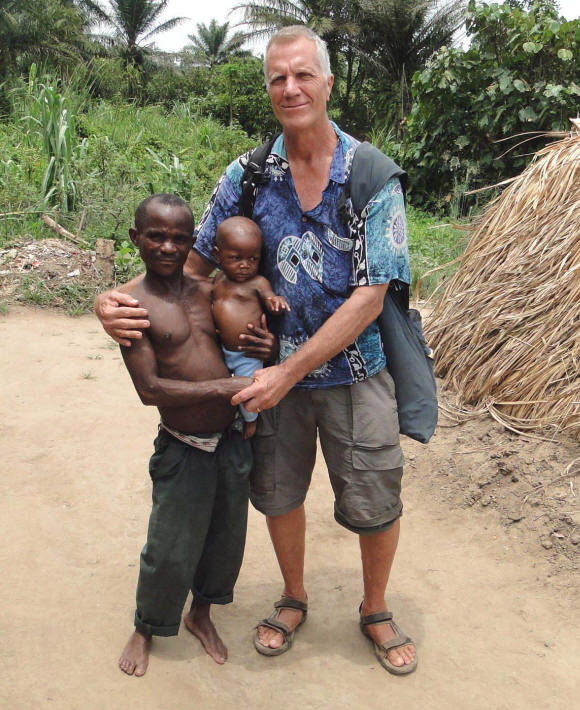
Batwa Pygmy King Nzito, welcomes Joseph to their village.
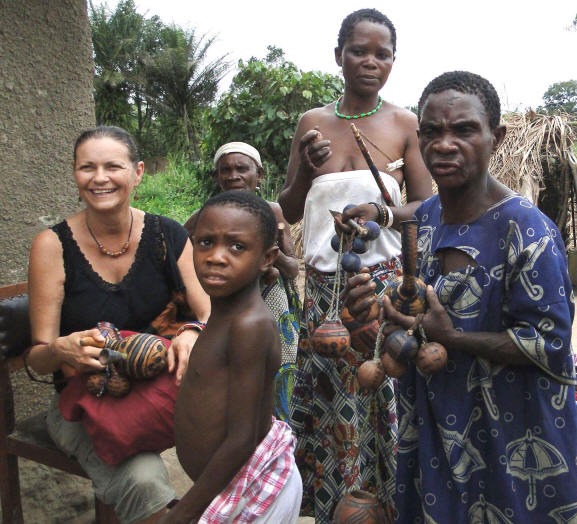
67 yr old, Asta Jona, (behind) was actually shorter than me when I was seated. A real character, she never left my side. All the women were thrilled as I handed out little bars of fancy hotel soap to take a coat of dust off.

